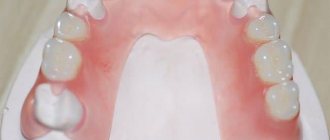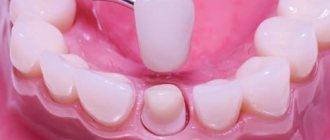Set on edge, set on edge: understanding the concepts
The word set on edge has deep roots; it comes from the old Russian verb “skomite”, which means “whining”, “to hurt”. In its modern meaning, soreness is the name given to painful sensations and a feeling of discomfort in the teeth or tongue. A sore throat appears from exposure of the teeth or oral mucosa to any irritant. Most often, spicy and sour foods. As a rule, an unpleasant symptom goes away quickly after eliminating the irritant (within 30 seconds), but sometimes it persists for quite a long time.
Important! Professional doctors believe that regardless of the frequency and duration of the discomfort, the symptom almost always indicates the presence of some kind of dental problem.
Oskoma or oskomina - what does it mean?
When people talk about soreness, they usually mean some discomfort associated with an astringent aftertaste in the mouth or aching pain in the teeth. Such sensations usually occur immediately after eating acid-containing foods. Sometimes the symptom is accompanied by slight numbness of the mucous membrane - a reaction of soft tissues to an irritant. More often than not, the sensations quickly pass, but it also happens that the soreness remains for a long time and causes serious inconvenience. As a rule, the prerequisite for this phenomenon is precisely hyperesthesia, that is, increased sensitivity of the enamel.
A sore throat is an unpleasant aftertaste in the mouth
The main reasons for the development of dental pathology
When asked why the sore throat appears, doctors, as a rule, answer unanimously - increased sensitivity or, scientifically, dental hyperesthesia is to blame1. Hard tissues respond to various stimuli because they are weakened, demineralized, thinned, or destroyed.
A sore throat appears in your mouth for a reason. Here are the main reasons why enamel and dentin can weaken and begin to react negatively to food acids:
- increased accumulation of hard mineralized plaque and stone,
- serious dental diseases and non-carious defects: caries, pulpitis, periodontitis, erosion, wedge-shaped defect, hypoplasia, fluorosis. The problem can be caused by periodontal inflammation, for example, periodontitis, which in an advanced stage causes recession (loss) of the gums, exposure of the roots and necks of teeth,
- bad household habits: opening bottles with teeth, biting threads, cracking nuts and seeds. Those who bite their nails or constantly hold foreign objects (pens, pencils) in their mouth are susceptible to the problem.
- non-compliance with teeth brushing techniques, use of brushes with hard bristles, abuse of abrasive and whitening pastes,
- destruction of hard tissues due to injuries, impacts and falls,
- eating too cold, hot and hard foods, as well as a love of acidic foods (juice, berries, tomatoes, coffee, apples, sauces, marinades) and sweet carbonated drinks - all this makes the enamel more porous, thins it, contributes to the appearance of erosions,
- changes in hormonal levels and disruption of mineral metabolism: teeth set on edge often occurs in pregnant and lactating women, since hard tissues are weakened due to a lack of beneficial microelements and calcium leaching from the body. The problem also occurs in women during menopause,
- bruxism,
- smoking.
The problem may occur in those who have undergone dental treatment with braces or in people who have had home or even professional whitening done.
How Covid-19 manifests itself in the mouth
COVID-19 leaves the body of an infected person in several ways: breathing, sneezing, talking, coughing, singing. All pathways involve the oral cavity. Therefore, when taking a coronavirus test, a swab is taken from the mouth and respiratory tract. Saliva is one of the main sources of transmission of the new coronavirus infection.
Remember, to protect yourself and your loved ones from coronavirus infection, you must wear medical masks and maintain social distance.
Coronavirus with complications in the oral cavity occurs in 45% of patients, complaints: dry mouth, rash on the mucous membrane, loss of taste, ulcers. However, complications of the virus may appear 12 days after the onset of the main symptoms and during the rehabilitation period. An oral infection from COVID-19 can also be asymptomatic, which complicates the treatment of the patient and the identification of the cause of complications in the oral cavity. Complications are associated with the poor state of the oral microflora, periodontal disease and other dental diseases, the treatment of which the patient postponed until later. From all this it follows that the connection between lack of oral care and the disease of the new coronavirus infection is close and it is always necessary to monitor your health.
Why does the tongue set on edge?
Some patients complain not only of teeth set on edge, but also of increased sensitivity of the tongue when eating sour foods. In this case, the pathology may be caused by a disease such as glossitis. In this case, the tongue may have cracks, ulcers or open wounds that bleed or are covered with plaque.
The problem may arise due to injury to a muscle organ as a result of biting, malocclusion, wearing a piercing, or a burn. Due to the presence of damaged and chipped teeth in the mouth, poorly installed dentures, crowns and worn fillings.
How pathology manifests itself at different stages
Doctors say that the appearance of a sore throat, namely pain and discomfort while eating sour food, is not even the first stage of the disease, but the second.
- The first or early stage of enamel hyperesthesia (hypersensitivity) is characterized by the following symptoms: hard tissues react to thermal stimuli, namely cold and hot temperatures of food (drinks).
- If you have the second, or moderate stage, then the tissues react not only to sour foods, but also to sweet, salty, and spicy foods.
- At the third, or advanced stage, pain and discomfort can be caused by any mechanical impact, for example, brushing and eating solid food.
Methods to help relieve the condition at home
If you periodically have a sore throat, then you will find useful tips that will help you quickly get rid of it at home.
Alkaline mouth rinses
Alkaline agents help quickly neutralize the effect of acid. To get rid of sore throat after eating acidic food, simply rinse your mouth with a solution of soda, milk or mineral water without carbonate, but with bicarbonate in the composition.
Eliminating irritating foods from your diet
If you don’t know how to remove the soreness on your teeth, then simply stop eating too sour and spicy foods, or reduce their consumption to a minimum. Remember that acidic foods and drinks are an additional factor contributing to the destruction and erosion of enamel, irritation and damage to the oral mucosa.
On a note! Try replacing acidic foods with ones that have a more neutral acid level. For example, if you like apples, you can choose less sour or not sour varieties.
Drinking sour drinks through a straw
Start drinking freshly squeezed juices and fruit drinks through a straw. This will help reduce the area exposed to the irritating factor.
Strengthening enamel
At home, you can use pastes for sensitive enamel and remineralizing compounds (Sensodyne, ROCS Sensitive Instant Relief or Medical Minerals, Colgate Sensitive Pro-Relief, PresiDENT Sensitive Plus). Today, such pastes are in the line of every budget and premium manufacturer.
It is necessary to strengthen the enamel not only from the outside, but also from the inside. Vitamin and mineral complexes will help with this, as well as foods rich in calcium, phosphorus, potassium and magnesium.
Ways to solve problems in dentistry
Experts believe that it is still better to treat sore throat not at home, but in dentistry. Because only a doctor can conduct a detailed diagnosis and establish the true cause of the problem.
How to remove the soreness on your teeth with the help of a dentist and make sure that the problem does not appear? Depending on the examination results and the clinical situation, the specialist may prescribe the following procedures:
- professional oral hygiene: carried out if there is soft and hard bacterial plaque on the teeth, which is the cause of many dental diseases that provoke increased sensitivity of the enamel,
- fluoridation and remotherapy: after these manipulations, the protective properties of hard tissues increase, their strength and resistance to irritating factors increases. During the procedure, the doctor seals the smallest cracks in the enamel, making its surface smooth and shiny,
- treatment of caries, pulpitis, periodontitis, gingivitis and periodontitis,
- installation of veneers and lumineers: microprosthetics with thin overlays is justified in cases of enamel hypersensitivity and the presence of other minor defects (chips, cracks, stains, gaps between teeth, unsightly shade, slight curvature and irregular shape of some teeth),
- prosthetics with crowns: this radical method is suitable only for those patients whose teeth are severely damaged,
- making and wearing night guards for bruxism,
- correction of bite pathologies with braces, trainers, aligners.
Tips and tricks from experts
We figured out what to do if a sore spot appears on your teeth, and how you can remove it yourself. Now let's move on to the question of how to prevent the development of hyperesthesia and its unpleasant consequences. Here's what experts recommend in this regard:
- Treat your teeth with care and avoid any traumatic factors. When choosing a suitable toothpaste and brush, it would be a good idea to consult with a specialist, and you certainly shouldn’t open bottles with your teeth or crack nut shells,
- maintain oral hygiene, do not forget to brush your teeth twice a day, use floss, preventive rinses and preferably an irrigator,
- Avoid sudden temperature changes in food and drinks. Rinse your mouth after eating sweet and sour foods,
- When the first signs of a problem appear, immediately go to the doctor.
Maintaining oral hygiene will help reduce the risk of pathology.
The most important thing is to seek professional help in a timely manner. Do not put off visiting a specialist if you often experience a feeling as if your teeth are set on edge. This may be a signal of more serious pathological processes that require urgent action. The dentist will help you recognize the problem in a timely manner, so you need to visit him for prevention at least twice a year.
- Bokaya, V.G. Deep fluoridation in the treatment of dental hypersensitivity, 2000.
Treatment of a sore tongue
If your teeth are set on edge, then you now know what to do. But if you are bothered by such unpleasant sensations on the tongue, then, as mentioned above, in most cases this indicates glossitis. There are many types of glossitis (allergic, herpetic, ulcerative, viral, hypertrophic, and so on). Each type of pathology is treated differently. To accurately determine the type and cause of this disease, you need to consult a doctor.
Read the article on the topic: “Symptoms, treatment, dental care for glossitis.”
Depending on the cause of the pathology, the doctor will prescribe a list of medications: antiseptics, antibiotics, ointments and antifungals.
Prevention is easier than cure - measures to prevent the problem
Professional doctors believe that sore throat can be easily avoided if you follow a number of preventive (prophylactic) measures.
Diet restrictions
You should not alternate cold and hot foods or get too carried away with sweet, spicy, salty, and sour foods. It is better to first separate solid foods into several small pieces. It is necessary to exclude from the diet carbonated drinks with phosphoric acid (Coca-Cola, Sprite, Fanta), which destroy and thin the enamel. You should also avoid eating sticky foods, crackers, chips and popcorn.
It must be remembered that teeth set on edge often appears due to careless treatment of enamel, so forget about cracking nuts and husking seeds with your teeth.
Using the right products to clean your teeth and gums
It will be better if you purchase personal hygiene products (paste, type of brush, type of floss and irrigator) after consulting a dentist, who will give valuable advice. The doctor will be guided by the condition of the gums, teeth and mucous membranes, and the presence of certain diseases.
Teeth whitening only in dentistry
Give preference to professional methods and whitening products used in dentistry. Remember that whitening pastes and folk remedies for home use (soda, salt, charcoal, lemon) can cause significant harm to the enamel and mucous membranes of the oral cavity, and the effect will be much more modest than what you get in dentistry.
What causes the problem?
Hyperesthesia occurs due to damage to the top layer of enamel. This is due to various reasons:
- Dental diseases: caries, periodontitis and pulpitis.
- Inflammatory processes in the gum tissue and oral mucosa.
- Bruxism.
- Bite pathologies.
- Exposing the necks of the teeth.
- Weakened enamel.
- Underdevelopment of enamel.
- Complication after a whitening or orthodontic treatment procedure.
- Intolerance to metal prosthetic structures.
- Injury to units due to bad habits.
There are several degrees of setback. Pathology can appear and immediately disappear. The reaction to the stimulus refers to the average degree of susceptibility. At the initial stage, the dentition reacts to temperature changes. In severe pathology, the sensation remains for a long period and causes discomfort when brushing your teeth.









